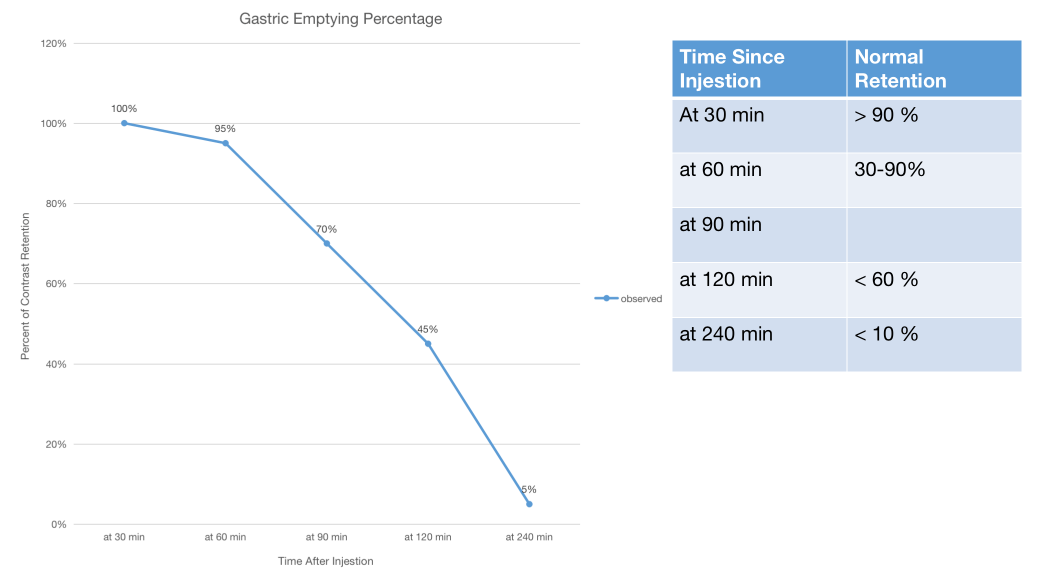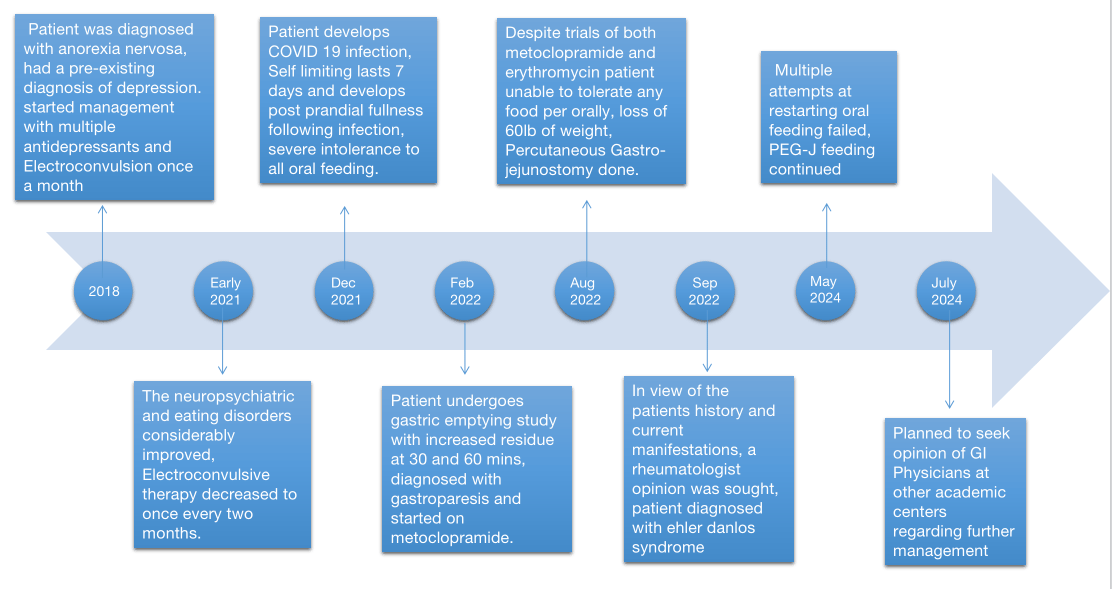Global Journal of Infectious Diseases and Clinical Research
A Three-way Attack on the Gastrointestinal System- COVID-19, Ehler-Danlos Syndrome, and Anorexia Nervosa Leading to Severe Gastroparesis in a Young Female
Jivtesh Singh1*, Shruti Vadali2 and Alka Aggarwal3
2MD, Internal Medicine, Gomel State Medical University, 5 Lange street, Central District, Gomel Region, Gomel, Belarus
3MD, Assistant Professor of Family Medicine, University of Central Florida, Florida, USA
Cite this as
Singh J, Vadali S, Aggarwal A. A Three-way Attack on the Gastrointestinal System- COVID-19, Ehler-Danlos Syndrome, and Anorexia Nervosa Leading to Severe Gastroparesis in a Young Female. Glob J Infect Dis Clin Res. 2024;10(1): 007-011. Available from: 10.17352/2455-5363.000060Copyright
© 2024 Singh J, et al. This is an open-access article distributed under the terms of the Creative Commons Attribution License, which permits unrestricted use, distribution, and reproduction in any medium, provided the original author and source are credited.A 28-year-old female with a past medical history of Major Depressive Disorder, Generalized Anxiety Disorder, Anorexia Nervosa, Chronic Pain Syndrome, and Gastro-esophageal Reflux presented to our clinic for establishing care in November 2022 with severe gastric dysmotility ever since contracting COVID-19 virus in December 2021. The patient’s symptoms were refractory to Erythromycin and metoclopramide therapy. A GI motility study in February 2022 showed delayed gastric emptying based on which the patient was diagnosed with Post COVID Gastroparesis. Based on an extensive clinical review of the patient’s past medical and surgical history, the patient was found to have cumulative symptoms of GERD, joint instability, abdominal hernia and chronic neuropathic pain, raising the suspicion of Ehler-Danlos syndrome- Hypermobility type. Given the failure of treatment with prokinetic agents and over 60 pounds of weight loss the patient underwent Percutaneous Endoscopic Gastrostomy-Jejunostomy in August 2022, the patient was started on Organic Tube Feeding Formula. To this date, the patient is using the PEG-J for feeding and remains nil per oral. Multiple trials of reintroducing oral feeding have been attempted but the patient still is unable to tolerate oral feeds completely and continues to complain of early satiety, nausea, and vomiting on reintroducing feeds.
Introduction
The term gastroparesis translates to “stomach paralysis’ and in its essence is a collection of symptoms such as nausea, vomiting, and early satiety with or without upper abdominal pain following meals in the absence of any mechanical obstruction to gastric emptying [1]. Normal gastric emptying is maintained by a complex series of interactions and synchronization between the sympathetic and parasympathetic systems, the enteric nervous system including the pacemaker cells, and the smooth musculature of the gut [2]. The etiology of Gastroparesis can be varied, one of the studies done including 148 patients reported the most common etiologies as idiopathic(36%), diabetic (29%), postgastric surgery(13%), 7.5% Parkinson’s disease(7.5%), 4.8% collagen vascular disorders(4.8%), intestinal pseudoobstruction (4.1%), and miscellaneous(6%) causes [3].
Coronavirus disease 2019 (COVID-19) is caused by infection with severe acute respiratory syndrome coronavirus 2 (SARS-CoV-2), which commonly presents with symptoms including fever, cough, and dyspnea. Towards the end of the pandemic, however, some patients having tested positive for COVID-19 began developing gastrointestinal (GI) symptoms either solely or in conjunction with respiratory symptoms. This may be due to SARS-CoV-2 infection of the GI tract [4]. Furthermore, COVID-19 infection and Ehler-Danlos syndrome appear to have a reciprocal interplay with one study suggesting longer more severe COVID-19 infection and duration in Ehler Danlos Patients [5]. Vice versa a reciprocal effect due to a chronic inflammatory state due to prolonged COVID has been observed in patients with Ehler-Danlos syndrome, especially cardiovascular complications [6]. This case is rather unique in that the gastrointestinal manifestations in gastroparesis are being exacerbated by COVID-19 infection in a patient with underlying active Ehler-Danlos syndrome. Such a case has not yet been described in the literature.
Case presentation
A 28-year-old female with a past medical history of Major Depressive Disorder, Generalized Anxiety disorder, Anorexia Nervosa, Chronic Pain Syndrome, and gastroesophageal reflux presented for the first time at the outpatient clinic for establishing care in November 2022. At that point, the patient informed that she had been struggling with severe gastric dysmotility ever since contracting the COVID-19 virus in December 2021. The patient further added that ever since the infection she had been unable to tolerate any oral food intake and had early satiety, bloating, severe stomach pain, and vomiting. Over the next 11 months till her presentation at the clinic, the patient lost nearly 60 pounds in weight. During that time the patient was being seen by her gastroenterologist and given a trial of both Erythromycin and Metoclopramide which were discontinued given no clinical response. The patient also underwent a GI motility study in February 2022 which showed delayed gastric emptying at the 30 and 60-minute mark but improvement at 120 minutes and near normalization at the 240-minute mark (Figure 1). Based on these study findings the patient was diagnosed as a case of Post COVID Gastroparesis at that time.
The patient has had a complicated history with a multitude of psychiatric disorders including Major depressive disorder and generalized anxiety disorder for which she is being managed with Brexipiprazole 0.5mg OD, Tranylcypromine 50 mg in two divided doses, and temazepam 45mg daily. Other than this patient also receives 1 session of Electro-Convulsive therapy every 2 months. The patient has been on the same psychiatric treatment regimen since 2021 and her symptoms have been adequately controlled, the frequency of ECT has been decreased from once monthly to once every two months since 2023. In the past, the patient was diagnosed with Anorexia nervosa (binging purging type with laxative abuse). A review of her records showed that she had maintained weight and BMI since 2018 till her COVID infection in December 2021 and her anorexia symptoms have been nonexistent since 2018.
At the time of presentation to the clinic, an extensive review of the patient’s past medical and surgical history was done. It was found that the patient had a surgical history of hernia repair in 1994, Eye surgeries in 1994, 2004, and 2010, and elbow surgery in 2018. Moreover, the patient also had severe Gastroesophageal reflux since 2014 and failed multiple trials of H2 blockers and Proton pump inhibitors until she ultimately underwent Gastric Valvuloplasty in 2018. In addition, the patient had a history of chronic arm pain following her elbow dislocation and developed neuropathic pain in her arm for which she had been taking Gabapentin 600mg for more than a decade. Based on her cumulative symptoms a suspicion of Ehler-Danlos Syndrome arose and the patient was referred to see a Rheumatologist. On evaluation by the specialist, a modified Beightons score of 11/11 was obtained, further the patient was screened for other connective tissue disorders but the ANA [Anti nuclear antibody] blot, RA [rheumatoid arthritis] diagnostic panel, and Scleroderma 12 antibody panel was negative. Based on these findings the patient was diagnosed as Ehler Danlos syndrome- Hypermobility type. The patient has also been evaluated in the past for fibromyalgia however failed to fulfill the criteria laid out by the American College of Rheumatology due to an alternative diagnosis in ehler Danlos syndrome and no consistent presence of symptoms for more than 3 months.
Returning to her Gastroparesis, which had resulted in a 60-lb weight loss and failed standard treatment with prokinetic agents, the patient underwent Percutaneous Endoscopic Gastrostomy-Jejunostomy in August 2022. She was started on Organic Tube Feeding Formula (Kate Farms 1.5 at a dose of 55ml/hour for 12 hours a day). The patient has remained compliant with PEG-J tube feeding and gets the Catheter replaced every 3 months. To this date, the patient is using the PEG-J for feeding and remains nil per oral. Multiple trials of reintroducing oral feeding have been attempted but the patient still is unable to tolerate oral feeds completely and continues to complain of early satiety, bloating, and vomiting on introducing oral feeds.
On discussion with the patient’s gastroenterologist, the patient is being planned to undergo a Sitzmark test to study her small bowel motility before any trials for further attempts to reintroduce oral feeds are done. For the time being PEG-J tube feeding is to be continued to allow for enteral nutrition for the patient. Figure 2 illustrates a brief timeline of events.
Discussion
We are presenting a case of a 28-year-old female with a host of comorbidities who developed gastroparesis following COVID-19 infection. Our patient her gastric dysmotility originated following a nonsevere COVID infection in December 2022 and since then the patient has been unable to tolerate any food orally. To maintain enteral feeding and gut continuity the patient was started on an Organic tube feed formula via PEG J tube, the formula used by Kate Farms 1.5 provides 1.5 kcal per mL with a blend of micronutrients to prevent any deficiency.
Such a presentation of Gastroparesis following a SARS-COV-2 virus which is primarily a respiratory virus is unusual. There are only a handful of case reports describing the same [7-10] .In comparison to the available case reports and one observational study most of the patients reported improvement in symptoms within 6 months of COVID-19 resolution but it is uncharacteristic that such a protracted course was observed. Such a long course makes this case different from the existing literature.
Furthermore, a few cases have been described where existing gastroparesis symptoms have been exacerbated in some patients [11,12 ]. However in our patient despite existing GI symptoms of acid reflux and a history of gastric fundoplasty, the patient never reported preexisting gastroparesis symptoms before the COVID-19 infection.
Furthermore, the patient’s history of GERD which did not respond to medical management and required gastric valvuloplasty and now new onset gastroparesis raises a very real possibility that Ehler-Danlos Syndrome may be playing a contributory role in her gastric dysmotility. EDS is considered a multisystem disorder, and its effects on connective tissue can involve the entire gastrointestinal (GI) tract in terms of both structure and function. Prior studies have shown that EDS, especially the hypermotility EDS subtype, is associated with a variety of GI symptoms and functional GI disorders like gastroparesis [13]. Our patient had a long history of symptoms of joint laxity and constellation of surgeries that seem to be linked to connective tissue dysfunction, similarly, her gastroparesis symptoms may be an interplay between post-COVID status and Ehler danlos syndrome [5].
Moreover, the patient history of complex eating disorders can also be a contributory prong in this offensive against the patient’s GI tract. It has been reported previously that even without the exacerbation of the eating disorder itself the patient can present with somatic symptoms and delayed gastric emptying [14]. The patient has had a distant history of anorexia nervosa (binging purging type with laxative abuse) in the past.
Other causes of similar presentation such as chronic autoimmune gastroenteritis were considered as they can lead to the presentation of dyspepsia and gastroparesis [15]. However, the sudden precipitation following the COVID-19 infection and the resolution of past symptoms of dyspepsia following gastric vavuloplasty make this diagnosis unlikely in the setting of no other supporting contributory findings. Also, the findings of UGI endoscopy before and following valvuloplasty have shown no evidence of autoimmune gastritis.
Guidelines suggest for a patient with gastroparesis the first line of management is replenishing the volume and electrolyte status, promoting gastric motility with pharmacological agents, and giving antiemetics. If the symptoms persist, a trial of naso-jejunal tube feeding may be tried to ensure intestinal motility is preserved. In our case, the patient was highly against the placement of an NG tube and hence the next line of management with PEG-J tube feeding was initiated. This is an acceptable intermediate-term management for up to 20 months to ensure nutritional status is maintained. However long-term use is discouraged due to the risk of infections and thrombosis [16].
The plan next for the patient is to undergo a Sitzmark study to ensure intestinal motility is preserved and then start the patient on incremental oral diets as tolerated starting with a homogenized solid food diet. In case the patient fails to tolerate alternative therapies such as pyloric interventions with botulinum injection, gastric stimulation devices or other experimental therapies may be considered [15].
Conclusion
The case we described epitomizes the struggle that primary care physicians and gastroenterologists face while managing a functional GI disorder like Gastroparesis. This is especially true in a setting where the disease process is being affected by multiple underlying disease processes like status post-COVID-19, Ehler-Danlos Syndrome, and multiple psychiatric disorders. This is further compounded by resistance to all first-line treatment options and the patient remaining persistently nontolerant to oral feeds. In our experience in managing such a challenging case, we believe that continuing enteral feed through the PEG-J tube is the best option even though the patient is beyond the recommended 20-month threshold. This allows for continued enteral feeding while allowing some time to explore other experimental options, counsel the patient on the long-term consequences of continued enteral nutrition and possibly re-attempt nasogastric feeding at a later stage to de-escalate PEG-J feeding.
Ethical declaration
All relevant patient consent forms were obtained before the submission of this manuscript and are available to the journal at the editor’s request.
- Camilleri M, Parkman HP, Shafi MA, Abell TL, Gerson L. Clinical guideline: management of gastroparesis. Am J Gastroenterol. 2013;108(1):18-37. Available from: https://doi.org/10.1038/ajg.2012.373
- Lacy BE, Parkman HP, Camilleri M. Chronic nausea and vomiting: evaluation and treatment. Am J Gastroenterol. 2018 May;113(5):647-59. Available from: https://doi.org/10.1038/s41395-018-0039-2
- Soykan I, Sivri B, Sarosiek I, Kiernan B, McCallum RW. Demography, clinical characteristics, psychological and abuse profiles, treatment, and long-term follow-up of patients with gastroparesis. Dig Dis Sci. 1998;43(11):2398-404. Available from: https://doi.org/10.1023/a:1026665728213
- Wong SH, Lui RN, Sung JJ. Covid-19 and the digestive system. J Gastroenterol Hepatol. 2020;35(5):744-748. Available from: https://doi.org/10.1111/jgh.15047
- Eccles JA, Cadar D, Quadt L, Hakim AJ, Gall N, Bowyer V, et al. Is joint hypermobility linked to self-reported non-recovery from COVID-19? Case-control evidence from the British COVID Symptom Study Biobank. BMJ Public Health. 2024;2:e000478. Available from: https://doi.org/10.1136/bmjph-2023-000478
- Guerrerio AL, Mateja A, MacCarrick G, Fintzi J, Brittain E, Frischmeyer-Guerrerio PA, et al. Web-based survey investigating cardiovascular complications in hypermobile Ehlers-Danlos syndrome after COVID-19 infection and vaccination. PLoS One. 2024;19(3):e0298272. Available from: https://doi.org/10.1371/journal.pone.0298272
- Patel A, Ali R, Hussain M, Slim J, DaCosta T. Severe Gastroparesis Flare: Is COVID-19 the Inciting Factor? Journal of Medical Cases. 2022;13(2):85-88. Available from: https://doi.org/10.14740/jmc3883
- Rusch CM, Molleston JM, Glasser MF, Don S, Kulkarni SS. Postviral Gastroparesis Associated With SARS-CoV-2 Infection in a Pediatric Patient. JPGN Rep. 2022;3(2):e195. Available from: https://doi.org/10.1097/pg9.0000000000000195
- Parkman H, Yates K, McCallum R, Koch K, Sarosiek I, Bulat R, et al. S650 Effects of COVID-19 in patients with gastroparesis: an analysis of patients in the NIH Gastroparesis Registry. Am J Gastroenterol. 2023;118 118(10S):S475. Available from: https://journals.lww.com/ajg/fulltext/2023/10001/s650_effects_of_covid_19_in_patients_with.1006.aspx#:~:text=to%20COVID%2D19.-,Conclusion%3A,primarily%20nausea%20and%20abdominal%20pain.
- Rustom LB, Telvizian T, Haddad S, Cohen DA. Gastroparesis and gastrointestinal dysmotility following COVID-19 infection. J Case Rep. 2022;11(4):221-4. Available from: http://dx.doi.org/10.17659/01.2021.0059
- Patel HK, Kovacic R, Chandrasekar VT, Patel SC, Singh M, Le Cam E, et al. Correlation of Gastrointestinal Symptoms at Initial Presentation with Clinical Outcomes in Hospitalized COVID-19 Patients: Results from a Large Health System in the Southern USA. Dig Dis Sci. 2022;67(11):5034-5043. Available from: https://doi.org/10.1007/s10620-022-07384-0
- Song J, Bhuta R, Baig K, Parkman HP, Malik Z. COVID-19 infection manifesting as a severe gastroparesis flare: a case report. Medicine (Baltimore). 2021;100(14):e25467. Available from: https://doi.org/10.1097%2FMD.0000000000025467
- Alomari M, Hitawala A, Chadalavada P, Covut F, Al Momani L, Khazaaleh S, et al. Prevalence and Predictors of Gastrointestinal Dysmotility in Patients with Hypermobile Ehlers-Danlos Syndrome: A Tertiary Care Center Experience. Cureus. 2020;12(4):e7881. Available from: https://doi.org/10.7759/cureus.7881
- Murray HB, Jehangir A, Parkman HP. History of eating disorder in patients with gastroparesis symptoms: more severe postprandial fullness and delayed gastric emptying. Am J Gastroenterol. 2018;113:S701-2. Available from: https://journals.lww.com/ajg/fulltext/2018/10001/history_of_eating_disorder_in_patients_with.1226.aspx
- Rossi RE, Elvevi A, Sciola V, Mandarino FV, Danese S, Invernizzi P, et al. Paradoxical association between dyspepsia and autoimmune chronic atrophic gastritis: Insights into mechanisms, pathophysiology, and treatment options. World J Gastroenterol. 2023;29(23):3733-3747. Available from: https://doi.org/10.3748/wjg.v29.i23.3733
- Zheng T, Camilleri M. Management of Gastroparesis. Gastroenterol Hepatol (NY). 2021;17(11):515-525. Available from: https://pubmed.ncbi.nlm.nih.gov/35466306/
Article Alerts
Subscribe to our articles alerts and stay tuned.
 This work is licensed under a Creative Commons Attribution 4.0 International License.
This work is licensed under a Creative Commons Attribution 4.0 International License.




 Save to Mendeley
Save to Mendeley
